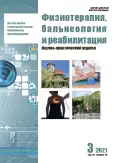The dynamics of allodynia in the treatment of patients with diabetic polyneuropathy using transcutaneous electroneurostimulation
- Authors: Al-Zamil M.K.1,2, Kulikova N.G.1, Vasilieva E.S.3, Elfimov M.A.4
-
Affiliations:
- Peoples' Friendship University of Russia
- "Olivia" Brain and Spine Clinic
- Moscow State University of Medicine and Dentistry named after A.I. Evdokimova
- Central State Medical Academy of Department of Presidential Affairs
- Issue: Vol 20, No 3 (2021)
- Pages: 187-192
- Section: Original studies
- URL: https://journals.rcsi.science/1681-3456/article/view/106149
- DOI: https://doi.org/10.17816/1681-3456-2021-20-187-192
- ID: 106149
Cite item
Abstract
BACKGROUND: Allodynia, hyperalgesia, and positive sensory symptoms are the main symptoms of neuropathic pain. Studying these symptoms and their dynamics in the treatment of neuropathic pain broadens our understanding of neuropathic pain and how it can be treated.
AIMS: To study the effect of different TENS modalities on allodynia in patients with severe neuropathic pain syndrome developed against the background of diabetic distal polyneuropathy of the lower extremities.
MATERIAL AND METHODS: 75 patients with allodynia on the background of distal polyneuropathy of the lower extremities (DPLE) were treated with pharmacotherapy (n=26), high-frequency TENS (n=25), and low-frequency TENS (n=24).
RESULTS: Immediately after treatment, we observed a more pronounced decrease in allodynia after the application of high-frequency TENS (by 72.2%) and low-frequency TENS (by 61.1%). Moreover, in the control group, the regression of allodynia averaged 28.6%. At the 2nd month of the long-term period, the severity of allodynia continued to decrease more rapidly against the background of high-frequency TENS (26.7%) than after low-frequency TENS (19%) and remained without significant dynamics against the background of pharmacotherapy.
CONCLUSION: The use of TENS 1.3 times enhances the therapeutic effect of pharmacotherapy in treatment of neuropathic pain in patients with diabetic DPLE. High-frequency TENS is more effective than low-frequency TENS in the treatment of allodynia by 18.2% immediately after treatment and by 40% at the end of the 2nd long-term period. By the 6th month of the long-term period, the results of treatment in both groups did not differ significantly.
Keywords
Full Text
##article.viewOnOriginalSite##About the authors
Mustafa Kh. Al-Zamil
Peoples' Friendship University of Russia; "Olivia" Brain and Spine Clinic
Author for correspondence.
Email: alzamil@mail.ru
ORCID iD: 0000-0002-3643-982X
SPIN-code: 3434-9150
MD, Dr. Sci. (Med.), Professor
Russian Federation, Moscow; PodolskNatalia G. Kulikova
Peoples' Friendship University of Russia
Email: alzamil@mail.ru
SPIN-code: 1827-7880
MD, Dr. Sci. (Med.), Professor
Russian Federation, MoscowEkaterina S. Vasilieva
Moscow State University of Medicine and Dentistry named after A.I. Evdokimova
Email: alzamil@mail.ru
ORCID iD: 0000-0003-3087-3067
SPIN-code: 5423-8408
MD, Dr. Sci. (Med.), Professor
Russian Federation, MoscowMikhail A. Elfimov
Central State Medical Academy of Department of Presidential Affairs
Email: alzamil@mail.ru
ORCID iD: 0000-0001-6153-9673
MD, Dr. Sci. (Med.)
Russian Federation, MoscowReferences
- Jensen TS, Finnerup NB. Allodynia and hyperalgesia in neuropathic pain: clinical manifestations and mechanisms. Lancet Neurol. 2014;13(9):924–935. doi: 10.1016/S1474-4422(14)70102-4
- Kukushkin M.L. Chronic pain. Neurology, Neuropsychiatry Psychosomatics. 2010;2(3):80–86. (In Russ). doi: 10.14412/2074-2711-2010-107
- Somers DL, Clemente FR. Transcutaneous electrical nerve stimulation for the management of neuropathic pain: the effects of frequency and electrode position on prevention of allodynia in a rat model of complex regional pain syndrome type II. Phys Ther. 2006;86(5):698–709.
- Aurilio C, Pota V, Pace MC, et al. Ionic channels and neuropathic pain: physiopathology and applications. J Cell Physiol. 2008;215(1):8–14. doi: 10.1002/jcp.21280
- Truini A, Garcia-Larrea L, Cruccu G. Reappraising neuropathic pain in humans — how symptoms help disclose mechanisms. Nat Rev Neurol. 2013;9(10):572–582. doi: 10.1038/nrneurol.2013.180
- Jardin K, Gregersen L, Røsland T, et al. Assessment of pain response in capsaicin-induced dynamic mechanical allodynia using a novel and fully automated brushing device. Pain Res Manag. 2013;18(1):6–10. doi: 10.1155/2013/142582
- Galstyan GR, Drobizhev MY, Surkova EV, et al. Pain in diabetic neuropathy ― psychosomatic aspects: a review. Problems Endocrin. 2007;53(6):43–47. (In Russ). doi: 10.14341/probl200753643-47
- Todd AJ. Neuronal circuitry for pain processing in the dorsal horn. Nat Rev Neurosci. 2010;11(12):823–836. doi: 10.1038/nrn2947
- Somers DL, Clemente FR. Contralateral high or a combination of high- and low-frequency transcutaneous electrical nerve stimulation reduces mechanical allodynia and alters dorsal horn neurotransmitter content in neuropathic rats. J Pain. 2009;10(2):221–229. doi: 10.1016/j.jpain.2008.08.008
- Woolf CJ. Central sensitization: implications for the diagnosis and treatment of pain. Pain. 2011;152(3 Suppl):2–15. doi: 10.1016/j.pain.2010.09.030
Supplementary files








